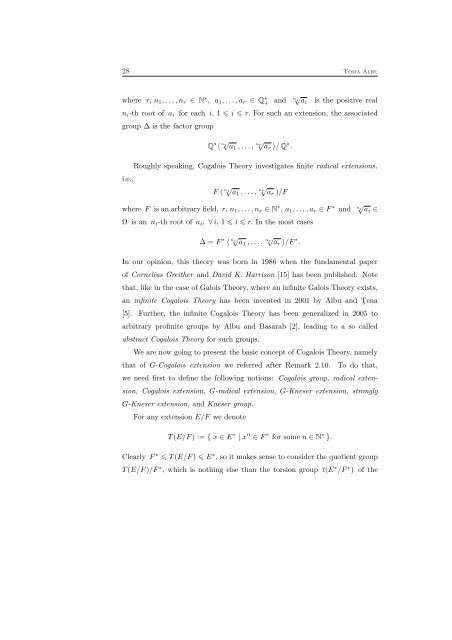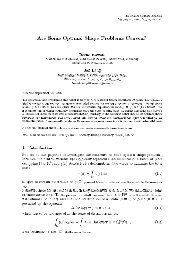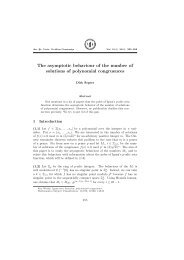the irrationality of sums of radicals via cogalois theory
the irrationality of sums of radicals via cogalois theory
the irrationality of sums of radicals via cogalois theory
- No tags were found...
You also want an ePaper? Increase the reach of your titles
YUMPU automatically turns print PDFs into web optimized ePapers that Google loves.
28 Toma Albuwhere r, n 1 , . . . , n r ∈ N ∗ , a 1 , . . . , a r ∈ Q ∗ + and √ n i a i is <strong>the</strong> positive realn i -th root <strong>of</strong> a i for each i, 1 i r. For such an extension, <strong>the</strong> associatedgroup ∆ is <strong>the</strong> factor groupQ ∗ 〈 √ n 1a 1 , . . . , √ n ra r 〉/ Q ∗ .Roughly speaking, Cogalois Theory investigates finite radical extensions,i.e.,F ( √ n 1a 1 , . . . , √ n ra r )/Fwhere F is an arbitrary field, r, n 1 , . . . , n r ∈ N ∗ , a 1 , . . . , a r ∈ F ∗ and √ n i a i ∈Ω is an n i -th root <strong>of</strong> a i , ∀ i, 1 i r. In <strong>the</strong> most cases∆ = F ∗ 〈 √ n 1a 1 , . . . , nr√ a r 〉/F ∗ .In our opinion, this <strong>the</strong>ory was born in 1986 when <strong>the</strong> fundamental paper<strong>of</strong> Cornelius Grei<strong>the</strong>r and David K. Harrison [15] has been published. Notethat, like in <strong>the</strong> case <strong>of</strong> Galois Theory, where an infinite Galois Theory exists,an infinite Cogalois Theory has been invented in 2001 by Albu and Ţena[5]. Fur<strong>the</strong>r, <strong>the</strong> infinite Cogalois Theory has been generalized in 2005 toarbitrary pr<strong>of</strong>inite groups by Albu and Basarab [2], leading to a so calledabstract Cogalois Theory for such groups.We are now going to present <strong>the</strong> basic concept <strong>of</strong> Cogalois Theory, namelythat <strong>of</strong> G-Cogalois extension we referred after Remark 2.10. To do that,we need first to define <strong>the</strong> following notions: Cogalois group, radical extension,Cogalois extension, G-radical extension, G-Kneser extension, stronglyG-Kneser extension, and Kneser group.For any extension E/F we denoteT (E/F ) := { x ∈ E ∗ | x n ∈ F ∗ for some n ∈ N ∗ }.Clearly F ∗ T (E/F ) E ∗ , so it makes sense to consider <strong>the</strong> quotient groupT (E/F )/F ∗ , which is nothing else than <strong>the</strong> torsion group t(E ∗ /F ∗ ) <strong>of</strong> <strong>the</strong>






